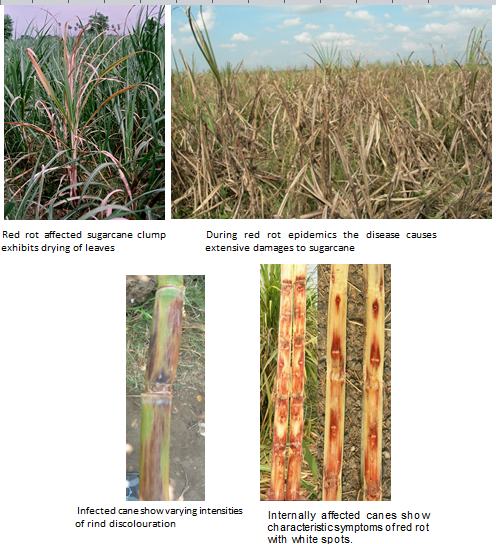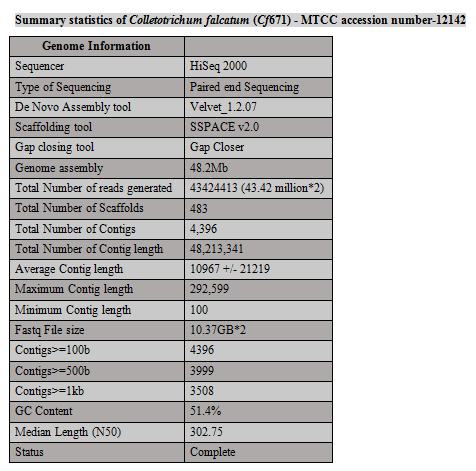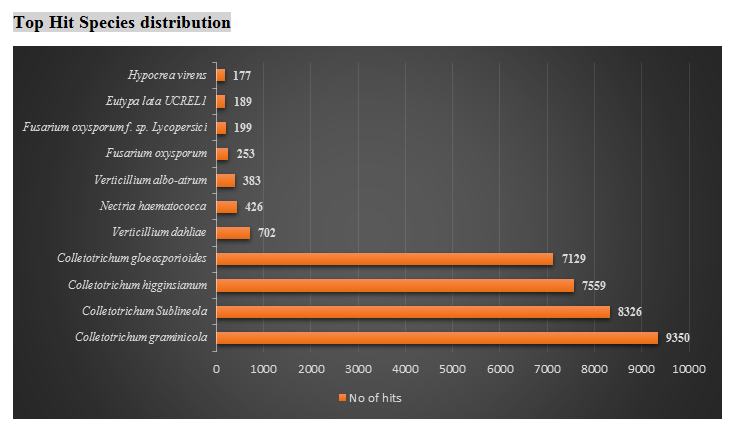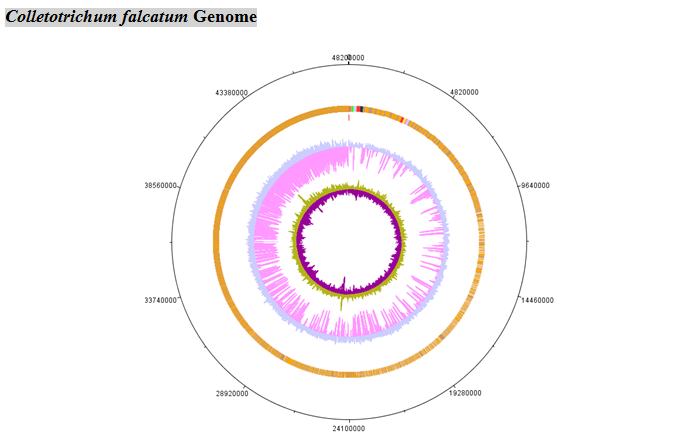Recent Achievements - Sugarcane Pathology
Yellow Leaf Disease (YLD) and its management
♥ Surveys by this Institute indicates that Yellow leaf disease (YLD) is emerging as the major threat to sugarcane cultivation in the country.
♥ Detailed studies indicated that in YLD affected canes there is a 37% reduction in cane weight; 15% reduction in cane diameter; and reduction in the number of internodes. Juice analysis revealed that there is comparative reduction in % brix, % sucrose and CCS % and purity% from diseased canes as compared to healthy canes. Cane productivity in the sugar mill area also showed a steady decline from 95 t/ha in 2000 to the lowest of 77.5 t/ha in 2009. Similarly sugar recovery in the mills showed a declining trend. It declined from 12.31% in 2000 to 11.11% in 2009. Overall, the mill performance data revealed that there is a gradual but steady decline in sugarcane productivity in the mill area, sugar percent in cane and sugar recovery due to YLD. This situation needs immediate attention to manage the disease by implementing healthy seed nursery programmes in the region.
♥ To successfully manage YLD, establishment of disease-free nurseries through tissue culture derived plants/ virus-free planting materials was demonstrated. Disease infected and disease-free seed canes of the ruling variety Co 86032 were planted side by side in bigger plots and plant growth and yield attributes were recorded at regular intervals. Both plant and ratoon crops of Co 86032 raised from virus-free planting materials exhibited a better crop stand compared to normal planting. The trial data indicated that the disease-free fields record 6.8 to 14.16 % increase in cane yield. .
♥ Complete genome (~5875 bp) of four SCYLV isolates from infected leaves of Co 86032, CoC 85061, CoV 92102 and B38192 was sequenced and characterized. Alignment of nucleotide sequences with reported genotypes placed the new isolates in a separate cluster; significant variations were noticed in ORF0 and 1. The reported genotypes had sequence variations of 29.2-31.8% with REU, 28.1-34.4% with HAW-PER and 30.7-33.4% with BRA in partial ORF0 sequences. The genotype CHN1, reported from China, shared close relationship with the new genotype IND1.
♥ To screen YLD resistance in sugarcane a 0-5 scoring system has been developed. Using the new score disease-free genotypes were identified in the germplasm and varietal collections.
♥Yellow leaf disease (YLD) is caused by Sugarcane yellow leaf virus (ScYLV), a Polerovirus, Luteoviridae occurs in major sugarcane growing countries across the world.
♥Primary mode of pathogen spread takes place through infected setts and secondary mode of transmission from one plant to others through insect vector Melanaphis sacchari
♥Healthy planting material selection and usage of tissue (apical meristem tip) culture seedlings are important for YLD management
♥To augment supply large-scale virus-free planting materials, single bud settlings obtained from tissue culture material can be raised in protrays under shade-net nursery and this procedure aids in faster multiplication of virus-free seed canes.
Gassy Shoot Disease
♥Primary spread of the disease through infected setts and secondary spread through phloem sap feeding insects
♥Disease free healthy planting material is important for the GSD management
♥Selection of planting materials in GSD affected clump and nearby clumps to be strictly avoided else, the disease expression would take place either in plant crop or in subsequent ratoons.
♥Aerated steam Therapy (AST) of planting setts at 50°C for 1 hour can eradicate or reduce the pathogen inoculum from setts without affecting the bud germination.
Red Rot-Genome Sequencing of Red Rot pathogen Using NGS Technology
♥ Colletotrichum falcatum, a concealed fungal ascomycete which causes red rot in sugarcane. It infects economically important stalk tissues, considered as store house of sugar in sugarcane. In addition, it is also known as bioenergy crop. Red rot caused by Colletotrichum falcatum, an intriguing pathogen caused several disease epidemics in India and limited information is available on its pathogenicity mechanisms. Ever since its report from India during 1902, the disease continues to be a major challenge to sugarcane cultivation in India and many other.
♥ C. falcatum enters the host through nodal tissues of sugarcane, does not form haustoria, and no apparent mechanical pressure is observed during its penetration into stalk. Unlike other Colletotrichum spp which infect leaf, twig, fruits etc. this fungus is specialized to infect sugarcane stalks and genomic information of this deadly pathogen has not been completely studied. Total nucleic acids were isolated from C. falcatum pathotype Cf671 (MTCC accession number-12142) and cDNA was sequenced on the Illumina Hi Seq 2000 (Genome Seq-Genotypic solutions, Bengaluru India. RNA-Seq- Xcleris Pvt Ltd, Ahmedabad, India).





Identifying proteins involved in red rot resistance through Proteomics
♥ Studies to identify proteome profiles from the stalk tissues of resistant (Co 93009) and susceptible (CoC 671) sugarcane varieties after pathogen inoculation by two-dimensional gel electrophoresis (2-DE) indicated that the number of protein spots was found to be higher (335 ± 7) in the resistant cultivar after 12 h of pathogen challenge. The inoculated susceptible cultivar had the lowest number of protein spots (280± 3).
♥ More than 250 protein spots that were detected in stalk tissues by proteomic analysis showed reproducible abundance within the replications.
♥ Approximately 50 protein spots were additionally induced in the resistant cultivar upon pathogen inoculation, whereas ~ 24 proteins have got down-regulated in the susceptible cultivar.
♥ Our studies on the proteome-level changes that occur during C. falcatum x sugarcane interaction using 2-DE are the first attempt to standardize proteome analysis and to identify specific proteins involved in red rot resistance in sugarcane.
♥ About 125 up/ down regulated proteins were characterized by peptide mass finger printing. Some of the identified proteins were putative callose synthase, R2R3-MYB transcription factor MYB6, p-coumarate 3-hydroxylase, PrLTP1 and PISTILLATA-like protein. Further validation of differential expression of the identified proteins by real time-PCR is in progress.
Screening for disease resistance in varieties
♥ 749 clones out of 2386 genotypes screened using CCT method exhibited resistance / tolerance to red rot. Genotypes Co 0327, Co 0331, Co 0424, Co 05009, Co 05010 and Co 05011 showed resistance to the disease under sub-tropical conditions.
Management of Red Rot
♥ Studies on the management of red rot with fungicides revealed that fungicide treatments protected the planted setts from soil borne inoculum and improved germination.
♥ Compatibility and increased efficacy of thiophanate methyl with new fungicides, viz. aureofungin and tricyclazole against red rot was demonstrated in pot culture and field experiments. Overnight soaking and short-term mechanized methods of sett treatment yielded similar response irrespective of planting material used
♥ Uptake/ infiltration of fungicide in sugarcane setts by vacuum infiltration was found to be equal to overnight soaking in different tissues like buds, rind, cut ends and internal tissue.
♥ Under field conditions overnight soaking of setts with ‘Nativo’ individually or in combination with ‘Cabrio’ or ‘Thiophanate methyl’ was found to protect the crop from soil borne inoculum of red rot and such treatments improved plant survival and millable canes.
♥ Among the SAR inducers used, BTH recorded the lowest red rot incidence (0.4%) upon challenge using Colletotrichum falcatum grain inoculum, followed by Cf-elicitor (2.3%) and GABA (2.9%)
♥ Three endophytic bacteria viz., ESR 3, ESR 24 and ESR 26 isolated from sugarcane possessed antagonistic potential, phosphate solubilization and siderophore production.
New differentials to identify variation in Red Rot
♥ Differential host pathogen interaction studies involving 14 differentials showed that the red rot pathotypes CF02, CF03 and CF09 are more virulent than the pathotypes CF08, CF01 and CF11 in North West zone.
♥ Among the four new isolates collected from Tamil Nadu, the isolates from CoSi 6 and Co 91017 were found to be more virulent. This study also revealed the virulence of the new pathotypes Cf98010, Cf94012, Cf6907 and Cf94003.
♥ Several varieties exhibited a clear differential interaction against red rot isolates from tropical region.
♥ New pathogen isolates were collected from Tamil Nadu, Haryana, AP and Bihar. Diversity work was initiated with 49 isolates of C. falcatum with two sets of β-tubulin primers. Nucleotide variations among the isolates showed that variable region 1 of β-tubulin gene (~545bp) has more nucleotide variations than variable region 2 of β-tubulin gene (~480bp) and actin gene.
Integrated Management of Red rot
♥ Selection of healthy disease-free planting material
♥ Mechanized sett treatment with Thiophanate methyl (TPM) at 1000 ppm (0.1%) or TPM at 500 ppm + 0.5% Paenibacillus alvei before planting
♥ Soil drenching or drip delivery of TPM at 0.1% alone or TPM at 500 ppm + 0.5% Paenibacillus alvei between 60 to 90 DAP
♥ If needed, foliar spray with TPM at 0.1% 90 DAP
♥ Application of Thiophanate methyl could be combined with Azoxystrobin and its combination with azoles/ Trifloxystrobin + Tebuconazole for enhanced efficacy by sett treatment and to avoid fungicide resistance.
♥ Soil application of Trichoderma will give additional protection and improve the growth of the crop
Molecular Diagnosis of Red Rot and Smut
♥ Comparison of molecular diagnostics with tissue bioassay indicated that PCR based diagnostics was found to be highly accurate to detect red rot in cane tissues.
♥ A protocol to isolate RNA and DNA from soil and PCR/RT-PCR based techniques were standardized to diagnose the presence of red rot and other fungal pathogens of sugarcane in the rhizospheric and non-rhizospheric soil.
♥ Primers were designed based on bE mating type gene of the smut pathogen and they specifically amplified the target gene (~454 bp) in asymptomatic plants with a latent infection of the smut pathogen. This PCR-based diagnostic technique is being revalidated over a large number of genotypes and PCR conditions will be optimized for repeatable results.
Pathogenicity Mechanism in C. falcatum
♥ The role of spore fluid toxin in red rot pathogenesis was established and this fraction was identified as the best source of toxin that can be utilized for structural elucidation of toxic substance.
Molecular basis of red rot resistance
♥ The full length cDNA (815bp) corresponding to the complete ORF of the sugarcane class IV chitinase was directly cloned into the pMAL-C4X protein expression vector. The recombinant plasmid was then transformed into the E. coli strain K12 and the chitinase protein was expressed as an MBP-chitinase fusion protein. The presence of chitinase in the recombinant protein was confirmed by Factor Xa cleavage, which cleaved the fusion protein into two fragments ~ 42.0 kDa and ~26 kDa corresponding to MBP and chitinase respectively.
♥ Gene specific forward and reverse primers were designed for fatty acid desaturase (FAD) and leucine rich protein (LRR) transcripts identified in DD-RT-PCR for their full length amplification through 5’-3’RACE. An amplicon of ~800bp was obtained for FAD.
♥ Optimized the amplification of the following transcription factors WRKY, MYB, TLP, NAC and BZIP from sugarcane using 42 sets of primers to study their role in pathogen recognition and signalling.
Wilt Disease of Sugarcane
Artificial reproduction of wilt Symptoms
♥ Detailed studies on artificial reproduction of wilt in sugarcane were conducted at Karnal and Gujarat under natural conditions and at Coimbatore a combination with drought and water logging was imposed along with pathogen inoculation. Disease evaluation using the standard plug method five months later revealed a very clear reproduction of wilt in a set of varieties at all the locations, whereas some of the varieties remain symptom-free indicating their resistance/tolerance.
Confirming pathogen identity
♥ Conflicting claims have been made regarding the true causal organism of sugarcane wilt as species of Fusarium, Cephalosporium and Acremonium by earlier authors. Since the associated pathogen has not been clearly established with the disease, detailed studies were conducted to identify the fungal species by pathogenicity and molecular variation. Studies on molecular variation using specific RAPD and ISSR markers were used to confirm the wilt pathogenic isolates of Fusarium. The molecular markers such as 1000bp fragment of RAPD primer OPA13, 650 bp fragment in ISSR1, 720 bp fragment in ISSR5 and 880 bp fragment in ISSR9 very clearly demarcated pathogenic and nonpathogenic isolates. The field and laboratory studies very clearly confirmed that the wilt pathogenic isolates belong to Fusarium sacchari and this is the first attempt that generated molecular markers which correlated with pathogeneicity of F. sacchari isolates.
Sugarcane Viruses
Production of antiserum to recombinant virus coat protein
♥ cDNA fragment coding for the partial ORF of the sugarcane streak mosaic virus (SCSMV) coat protein gene (~850bp) was cloned into the EcoRI site of the protein expression vector pMAL-C4X. The recombinant plasmid was then transformed and the SCSMV-CP was expressed as an MBP-SCSMV-CP fusion protein. The expressed protein was used as antigen to raise highly specific antisera for the diagnosis of the virus. Higher sensitivity of the serum was confirmed in ELISA and IC-RT-PCR.
Molecular diagnosis of sugarcane viruses
♥ A multiplex reverse transcription polymerase chain reaction (M-RT-PCR) was developed for the detection of sugarcane mosaic virus (SCMV), sugarcane streak mosaic virus (SCSMV) and sugarcane yellow leaf virus (SCYLV), three of the major RNA viruses widely prevailing in the sugarcane growing regions around the world. Primers designed from the coat protein genes of the respective viruses amplified fragments of ~860 bp (SCMV), ~690 bp (SCSMV) and 615 bp (SCYLV) in M-RT-PCR. In this study we could specifically detect the target viruses in disease suspected sugarcane cultivars. Out of nine samples four were found infected with all the three targeted viruses, two had infections of SCMV and SCSMV and the remaining three samples had the viruses found separately. The sequence information of the M-RT-PCR products has confirmed their authenticity of the respective viruses. Furthermore, multiplex-RT-PCR was found to be equally efficient to uniplex RT-PCR to amplify the target viruses from sugarcane.
Accredited test lab for virus indexing
♥ The Plant Pathology lab is an accredited lab for virus testing of tissue culture raised sugarcane plants under National Certification System for Tissue Culture raised Plants (NCS-TCP) of Department of Biotechnology, New Delhi. The virus indexing service was offered to sugarcane tissue culture production units in the country. Tissue culture plantlets are being received from various tissue culture production laboratories in Tamil Nadu, Andhra Pradesh, Gujarat and Maharashtra were screened for the presence of SCYLV, SCSMV, SCMV and grassy shoot phytoplasmas by RT-PCR/PCR techniques and indexed. This would facilitate supply of disease-free planting materials in different states and improve cane productivity.
Protection Technology of Sugarcane
Management of rust of sugarcane
Two spraying of 0.3% mancozeb 75 WP (4g /l water) or 0.05% carbendazim 50WP (1g / 1 l) or 0.01% propiconazole 25 EC (0.4 ml /l) is recommended at 15 days intervals from the initiation of the symptoms.
Management of Pokkah Boeng in sugarcane
Spraying of sugarcane crown region with 0.05% carbendazim 50WP (1g/l water) or 0.01% propiconazole 25 EC (0.4 ml /l) is recommended immediately after observing the PB symptoms during monsoon season
Contact Address
-
ICAR-Sugarcane Breeding Institute
Veerakeralam,
Coimbatore 641007
Tamil Nadu. - Phone: 0422 - 2472621
- Email: director.sbi@icar.gov.in
- GST Number 33AAAAD2962K2ZT
Our Visitor Count







